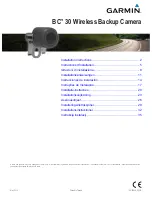
93
ķ
with a CPU (i.e., lenses without auto focus mode), results in certain
functional limitations.
3. Preparing the flash unit for use
3.1 Mounting the flash unit
Mounting the flash unit on the camera
Turn off the camera and flash before mounting or removing.
• Turn the knurled nut
towards the flash unit housing as far as it will go.
The locking pin in the adapter shoe is now fully retracted into the case.
• Slide the flash unit foot completely into the camera accessory shoe.
• Turn the knurled nut
towards the camera housing as far as it will go,
clamping the flash unit in place. If the camera does not have a locking
hole, the spring-loaded locking pin retracts into the adapter case so as not
to damage the surface.
Removing the flash unit from the camera
Turn off the camera and flash before mounting or dismounting.
• Turn the knurled nut
towards the flash unit housing as far as it will go.
• Remove the flash unit from the camera’s accessory shoe.
3.2 Power supply
Suitable batteries/rechargeable batteries
The flash unit can be operated with any of the following batteries:
• 4 NiCad batteries 1.2V, type IEC KR 15/51 (KR6, size AA). They permit
very fast recycling times and are economical in use because they are
rechargeable.
• 4 nickel-metal-hydride batteries 1.2V, type HR6 (size AA). They have a sig-
nificantly higher capacity than NiCad batteries and are less harmful to the
environment, since they have no cadmium.
• 4 alkaline-manganese dry cell batteries 1.5V, type IEC LR6 (size AA).
Maintenance-free power source for moderate power requirements.
☞
☞
• 4 lithium batteries 1.5V, type IEC FR6 L91 (size AA). Maintenance-free
high-capacity power source with a low self-discharge rate.
• Power Pack P76 with connecting cable V58-50 (optional accessory)
If your flash unit is not going to be used for an extended period of
time, remove the batteries.
Replacing batteries
The batteries are flat or dead if the recycling time (elapsing from the trigge-
ring of a full-power flash, e.g. in the M mode, to the moment the flash ready
indicator
lights up again) exceeds 60 seconds.
• Turn off the flash unit at the main switch
.
• Slide the battery compartment cover
downwards and fold open.
• Insert the batteries lengthwise as indicated by the battery symbols on the
flash unit, and close the battery compartment cover
.
When inserting batteries, ensure that the polarity is correct and mat-
ches the symbols in the battery compartment. Inserting the batteries in
the wrong direction can destroy the flash unit!
Always replace all batteries simultaneously, and make sure that batte-
ries are the same brand and have the same capacity.
Flat or dead batteries should not be disposed of with ordinary house-
hold waste. Help protect the environment, and dispose of flat/dead
batteries at the appropriate collection points.
3.3 Switching the flash unit on and off
The flash unit can be turned on by flipping the main switch
to the „ON“
position.
To turn off the flash unit, flip the main switch
to the left position.
If your flash unit is not going to be used for an extended period of
time, we recommend turning it off with the main switch and removing
the power source (i.e., batteries).
☞
☞
☞
706 47 0029-A3 58 AF-1 N 30.05.2007 8:05 Uhr Seite 93
















































